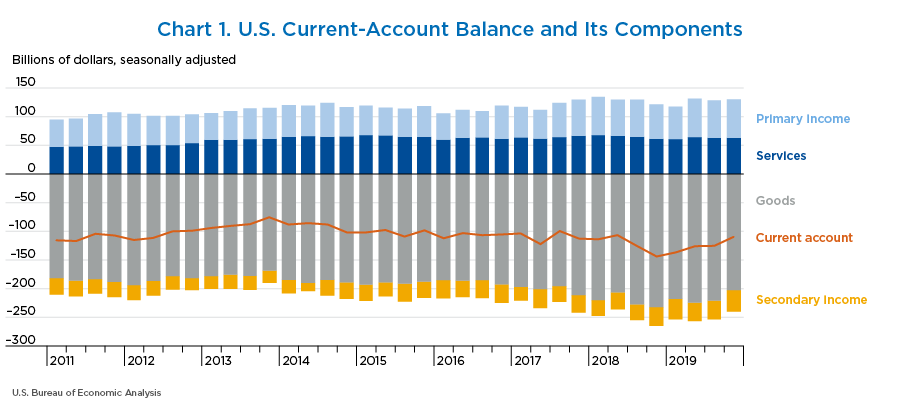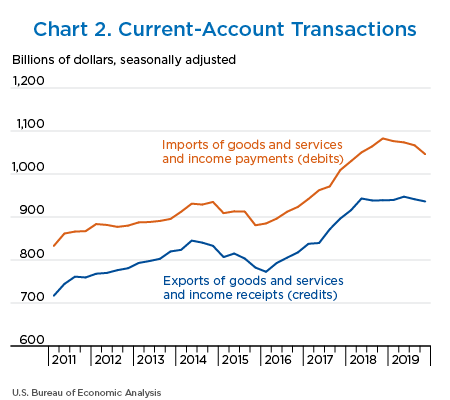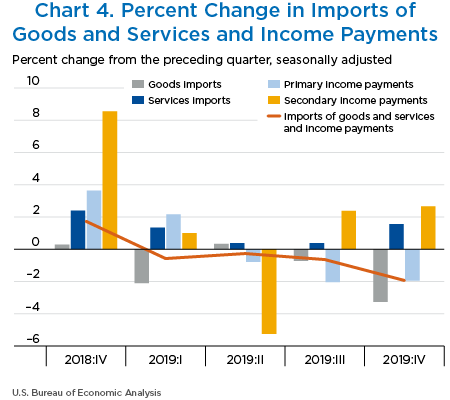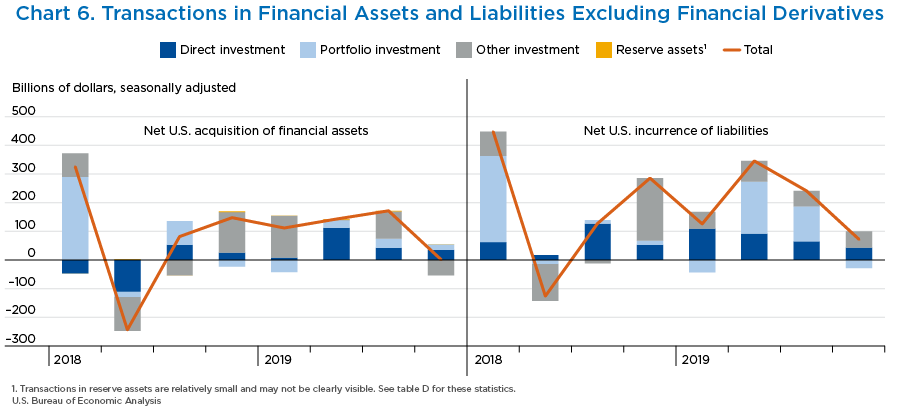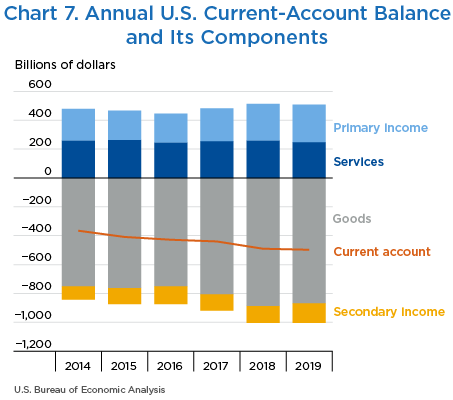U.S. International Transactions
Fourth Quarter and Year 2019
The U.S. current-account deficit, which reflects the combined balances on trade in goods and services and income flows between U.S. residents and residents of other countries, narrowed by $15.6 billion, or 12.4 percent, to $109.8 billion in the fourth quarter of 2019 (chart 1 and table A). The revised third-quarter deficit was $125.4 billion.
The deficit was 2.0 percent of current-dollar gross domestic product (GDP), down from 2.3 percent in the third quarter.
The $15.6 billion narrowing of the current-account deficit in the fourth quarter mainly reflected a reduced deficit on goods that was partly offset by an expanded deficit on secondary income.
The U.S. current-account deficit widened by $7.4 billion, or 1.5 percent, to $498.4 billion in 2019. The deficit was 2.3 percent of current-dollar GDP, down from 2.4 percent in 2018.
| 2019 | Change 2019:III to 2019:IV | ||||
|---|---|---|---|---|---|
| I r | II r | III r | IV p | ||
| Current account | |||||
| Exports of goods and services and income receipts (credits) | 939,453 | 947,211 | 941,193 | 936,087 | −5,106 |
| Exports of goods and services | 625,487 | 625,475 | 623,413 | 623,658 | 245 |
| Goods | 417,623 | 413,217 | 412,244 | 409,722 | −2,522 |
| Services | 207,865 | 212,258 | 211,169 | 213,936 | 2,767 |
| Primary income receipts | 278,151 | 286,155 | 280,808 | 277,987 | −2,821 |
| Secondary income (current transfer) receipts | 35,814 | 35,581 | 36,972 | 34,441 | −2,531 |
| Imports of goods and services and income payments (debits) | 1,076,351 | 1,073,464 | 1,066,571 | 1,045,908 | −20,663 |
| Imports of goods and services | 783,245 | 785,865 | 781,836 | 763,512 | −18,324 |
| Goods | 635,666 | 637,734 | 633,142 | 612,506 | −20,636 |
| Services | 147,579 | 148,131 | 148,694 | 151,006 | 2,312 |
| Primary income payments | 221,112 | 219,385 | 214,903 | 210,704 | −4,199 |
| Secondary income (current transfer) payments | 71,994 | 68,213 | 69,832 | 71,692 | 1,860 |
| Capital account | |||||
| Capital transfer receipts and other credits | 0 | 0 | 0 | 0 | 0 |
| Capital transfer payments and other debits | 0 | 0 | 10 | n.a. | n.a. |
| Financial account | |||||
| Net U.S. acquisition of financial assets excluding financial derivatives (net increase in assets / financial outflow (+)) | 111,706 | 142,647 | 171,561 | 998 | −170,563 |
| Direct investment assets | 8,617 | 111,767 | 42,085 | 35,202 | −6,883 |
| Portfolio investment assets | −41,876 | 26,706 | 32,106 | 18,939 | −13,167 |
| Other investment assets | 144,757 | 1,815 | 95,488 | −53,352 | −148,840 |
| Reserve assets | 208 | 2,359 | 1,882 | 210 | −1,672 |
| Net U.S. incurrence of liabilities excluding financial derivatives (net increase in liabilities / financial inflow (+)) | 125,661 | 345,328 | 241,596 | 71,855 | −169,741 |
| Direct investment liabilities | 109,459 | 92,686 | 65,171 | 43,495 | −21,676 |
| Portfolio investment liabilities | −42,822 | 181,016 | 121,606 | −28,183 | −149,789 |
| Other investment liabilities | 59,023 | 71,626 | 54,820 | 56,543 | 1,723 |
| Financial derivatives other than reserves, net transactions | −21,421 | −9,642 | −6,382 | −933 | 5,449 |
| Statistical discrepancy | |||||
| Statistical discrepancy1 | 101,523 | −86,071 | 48,972 | 38,032 | −10,940 |
| Balances | |||||
| Balance on current account | −136,898 | −126,252 | −125,378 | −109,822 | 15,556 |
| Balance on goods and services | −157,758 | −160,390 | −158,423 | −139,854 | 18,569 |
| Balance on goods | −218,044 | −224,517 | −220,899 | −202,784 | 18,115 |
| Balance on services | 60,286 | 64,128 | 62,476 | 62,930 | 454 |
| Balance on primary income | 57,039 | 66,769 | 65,905 | 67,283 | 1,378 |
| Balance on secondary income | −36,180 | −32,632 | −32,860 | −37,251 | −4,391 |
| Balance on capital account | 0 | 0 | −10 | 0 | 10 |
| Net lending (+) or net borrowing (-) from current- and capital-account transactions2 | −136,898 | −126,252 | −125,389 | −109,822 | 15,567 |
| Net lending (+) or net borrowing (-) from financial-account transactions3 | −35,376 | −212,323 | −76,417 | −71,790 | 4,627 |
- p
- Preliminary
- r
- Revised
- n.a.
- Not available
- The statistical discrepancy is the difference between net acquisition of financial assets and net incurrence of liabilities in the financial account (including financial derivatives) less the difference between total credits and total debits recorded in the current and capital accounts.
- Sum of current- and capital-account balances.
- Sum of net U.S. acquisition of financial assets and net transactions in financial derivatives less net U.S. incurrence of liabilities.
Note. The statistics are presented in table 1.2 on BEA’s website.
Exports of goods and services to, and income received from, foreign residents decreased $5.1 billion to $936.1 billion in the fourth quarter (charts 2 and 3 and table B). Imports of goods and services from, and income paid to, foreign residents decreased $20.7 billion to $1.05 trillion (charts 2 and 4 and table C).
Trade in goods
Exports of goods decreased $2.5 billion to $409.7 billion, led by a decrease in foods, feeds, and beverages, mainly soybeans. Changes in the other major categories were nearly offsetting. Imports of goods decreased $20.6 billion to $612.5 billion, mainly reflecting decreases in consumer goods, led by apparel, footwear, and household goods, and in automotive, vehicles, parts, and engines, led by trucks, buses, and special purpose vehicles.
Trade in services
Exports of services increased $2.8 billion to $213.9 billion, mainly reflecting increases in travel, primarily other personal travel, and in other business services, mostly professional and management consulting services. Imports of services increased $2.3 billion to $151.0 billion, reflecting increases in all major categories. Increases were led by travel, mainly other personal travel.
Primary income
Receipts of primary income decreased $2.8 billion to $278.0 billion, and payments of primary income decreased $4.2 billion to $210.7 billion. The decreases in both receipts and payments mainly reflected decreases in other investment income, mostly interest on loans and deposits.
Secondary income
Receipts of secondary income decreased $2.5 billion to $34.4 billion, mainly reflecting a decrease in private sector fines and penalties, a component of private transfer receipts. Payments of secondary income increased $1.9 billion to $71.7 billion, mainly reflecting an increase in U.S. government grants.
| 2019 | Change 2019:III to 2019:IV | ||||
|---|---|---|---|---|---|
| I r | II r | III r | IV p | ||
| Exports of goods and services and income receipts | 939,453 | 947,211 | 941,193 | 936,087 | −5,106 |
| Exports of goods | 417,623 | 413,217 | 412,244 | 409,722 | −2,522 |
| General merchandise | 412,906 | 408,967 | 407,162 | 404,031 | −3,131 |
| Foods, feeds, and beverages | 31,835 | 34,304 | 33,926 | 31,068 | −2,858 |
| Industrial supplies and materials | 130,523 | 132,768 | 129,503 | 132,911 | 3,408 |
| Energy products | 53,380 | 56,888 | 54,645 | 59,081 | 4,436 |
| Of which: Petroleum and products | 45,951 | 49,417 | 47,394 | 50,874 | 3,480 |
| Nonenergy products | 77,143 | 75,880 | 74,858 | 73,830 | −1,028 |
| Capital goods except automotive | 141,791 | 135,408 | 134,842 | 135,322 | 480 |
| Automotive vehicles, parts, and engines | 41,306 | 40,287 | 41,491 | 38,764 | −2,727 |
| Consumer goods except food and automotive | 52,826 | 51,328 | 51,675 | 49,860 | −1,815 |
| Other general merchandise | 14,624 | 14,873 | 15,724 | 16,106 | 382 |
| Net exports of goods under merchanting | 92 | 85 | 139 | 114 | −25 |
| Nonmonetary gold | 4,625 | 4,165 | 4,943 | 5,577 | 634 |
| Exports of services1 | 207,865 | 212,258 | 211,169 | 213,936 | 2,767 |
| Maintenance and repair services n.i.e. | 8,069 | 7,750 | 8,211 | 8,495 | 284 |
| Transport | 23,040 | 23,270 | 22,621 | 22,426 | −195 |
| Travel (for all purposes including education) | 54,190 | 53,373 | 52,409 | 53,511 | 1,102 |
| Business | 9,528 | 9,572 | 9,245 | 9,514 | 269 |
| Personal | 44,661 | 43,801 | 43,164 | 43,997 | 833 |
| Insurance services | 4,404 | 4,359 | 4,731 | 4,787 | 56 |
| Financial services | 27,316 | 28,710 | 27,639 | 27,610 | −29 |
| Charges for the use of intellectual property n.i.e. | 31,568 | 32,741 | 32,210 | 32,413 | 203 |
| Telecommunications, computer, and information services | 11,414 | 11,894 | 12,045 | 12,460 | 415 |
| Other business services | 42,974 | 44,885 | 45,620 | 46,592 | 972 |
| Government goods and services n.i.e. | 4,890 | 5,277 | 5,684 | 5,642 | −42 |
| Primary income receipts | 278,151 | 286,155 | 280,808 | 277,987 | −2,821 |
| Investment income | 276,447 | 284,445 | 279,095 | 276,279 | −2,816 |
| Direct investment income | 143,551 | 147,657 | 143,460 | 145,320 | 1,860 |
| Income on equity | 137,075 | 141,172 | 136,681 | 138,556 | 1,875 |
| Dividends and withdrawals | 95,272 | 69,909 | 99,449 | 96,278 | −3,171 |
| Reinvested earnings | 41,803 | 71,263 | 37,232 | 42,278 | 5,046 |
| Interest | 6,476 | 6,485 | 6,779 | 6,764 | −15 |
| Portfolio investment income | 103,721 | 107,619 | 108,474 | 107,829 | −645 |
| Income on equity and investment fund shares | 68,621 | 72,181 | 72,761 | 71,740 | −1,021 |
| Interest on debt securities | 35,100 | 35,438 | 35,713 | 36,089 | 376 |
| Other investment income | 28,943 | 28,921 | 26,918 | 22,978 | −3,940 |
| Reserve asset income | 231 | 248 | 243 | 151 | −92 |
| Compensation of employees | 1,704 | 1,710 | 1,712 | 1,709 | −3 |
| Secondary income (current transfer) receipts2 | 35,814 | 35,581 | 36,972 | 34,441 | −2,531 |
- p
- Preliminary
- r
- Revised
- n.i.e.
- Not included elsewhere
- See also Shari A. Allen, Thomas Anderson, and Alexis N. Grimm, “U.S. International Services: Trade in Services in 2018 and Services Supplied Through Affiliates in 2017,” Survey of Current Business 99 (October 2019).
- Secondary income receipts include U.S. government and private transfers, such as fines and penalties, withholding taxes, insurance-related transfers, and other current transfers.
| 2019 | Change 2019:III to 2019:IV | ||||
|---|---|---|---|---|---|
| I r | II r | III r | IV p | ||
| Imports of goods and services and income payments | 1,076,351 | 1,073,464 | 1,066,571 | 1,045,908 | −20,663 |
| Imports of goods | 635,666 | 637,734 | 633,142 | 612,506 | −20,636 |
| General merchandise | 633,756 | 635,959 | 630,218 | 608,496 | −21,722 |
| Foods, feeds, and beverages | 37,469 | 38,589 | 38,363 | 37,175 | −1,188 |
| Industrial supplies and materials | 134,407 | 136,746 | 130,170 | 127,651 | −2,519 |
| Energy products | 54,903 | 60,942 | 54,077 | 53,410 | −667 |
| Of which: Petroleum and products | 50,514 | 57,443 | 50,700 | 49,778 | −922 |
| Nonenergy products | 79,504 | 75,804 | 76,093 | 74,241 | −1,852 |
| Capital goods except automotive | 172,332 | 170,706 | 169,703 | 168,810 | −893 |
| Automotive vehicles, parts, and engines | 95,396 | 96,867 | 95,636 | 89,057 | −6,579 |
| Consumer goods except food and automotive | 167,453 | 165,124 | 167,726 | 155,863 | −11,863 |
| Other general merchandise | 26,698 | 27,926 | 28,621 | 29,940 | 1,319 |
| Nonmonetary gold | 1,911 | 1,775 | 2,924 | 4,010 | 1,086 |
| Imports of services1 | 147,579 | 148,131 | 148,694 | 151,006 | 2,312 |
| Maintenance and repair services n.i.e. | 2,164 | 2,277 | 2,175 | 2,207 | 32 |
| Transport | 27,931 | 27,455 | 27,245 | 27,485 | 240 |
| Travel (for all purposes including education) | 37,774 | 37,773 | 37,905 | 38,869 | 964 |
| Business | 4,035 | 3,964 | 4,020 | 3,942 | −78 |
| Personal | 33,739 | 33,809 | 33,884 | 34,927 | 1,043 |
| Insurance services | 11,680 | 12,131 | 12,337 | 12,433 | 96 |
| Financial services | 8,448 | 8,385 | 8,396 | 8,440 | 44 |
| Charges for the use of intellectual property n.i.e. | 14,258 | 14,243 | 14,155 | 14,416 | 261 |
| Telecommunications, computer, and information services | 10,309 | 10,762 | 10,934 | 11,151 | 217 |
| Other business services | 29,113 | 29,142 | 29,441 | 29,870 | 429 |
| Government goods and services n.i.e. | 5,903 | 5,962 | 6,105 | 6,135 | 30 |
| Primary income payments | 221,112 | 219,385 | 214,903 | 210,704 | −4,199 |
| Investment income | 216,142 | 214,373 | 209,762 | 205,508 | −4,254 |
| Direct investment income | 65,138 | 61,618 | 59,176 | 59,839 | 663 |
| Portfolio investment income | 119,776 | 121,649 | 122,038 | 121,769 | −269 |
| Income on equity and investment fund shares | 40,849 | 42,723 | 42,538 | 42,047 | −491 |
| Interest on debt securities | 78,927 | 78,926 | 79,500 | 79,723 | 223 |
| Other investment income | 31,228 | 31,106 | 28,548 | 23,901 | −4,647 |
| Compensation of employees | 4,970 | 5,013 | 5,142 | 5,195 | 53 |
| Secondary income (current transfer) payments2 | 71,994 | 68,213 | 69,832 | 71,692 | 1,860 |
| Supplemental detail on insurance transactions: | |||||
| Premiums paid | 31,142 | 31,603 | 32,007 | 31,872 | −135 |
| Losses recovered | 19,789 | 19,415 | 18,922 | 18,896 | −26 |
- p
- Preliminary
- r
- Revised
- n.i.e.
- Not included elsewhere
- See also Shari A. Allen, Thomas Anderson, and Alexis N. Grimm, “U.S. International Services: Trade in Services in 2018 and Services Supplied Through Affiliates in 2017,” Survey of Current Business 99 (October 2019).
- Secondary income payments include U.S. government and private transfers, such as U.S. government grants and pensions, fines and penalties, withholding taxes, personal transfers (remittances), insurance-related transfers, and other current transfers.
Net financial-account transactions were −$71.8 billion in the fourth quarter, reflecting net U.S. borrowing from foreign residents.
Financial assets
Fourth-quarter transactions increased U.S. residents' foreign financial assets by $1.0 billion (charts 5 and 6 and table D). Transactions increased direct investment assets, mainly equity, by $35.2 billion; portfolio investment assets by $18.9 billion, resulting from large and mostly offsetting transactions in equity securities and debt securities; and reserve assets by $0.2 billion. Transactions decreased other investment assets, primarily loans, by $53.4 billion.
Liabilities
Fourth-quarter transactions increased U.S. liabilities to foreign residents by $71.9 billion. Transactions increased direct investment liabilities, mainly equity, by $43.5 billion and other investment liabilities, mainly loans, by $56.5 billion. Transactions decreased portfolio investment liabilities, mainly short-term debt securities, by $28.2 billion.
Financial derivatives
Net transactions in financial derivatives were −$0.9 billion in the fourth quarter, reflecting net borrowing from foreign residents.
| 2019 | Change 2019:III to 2019:IV | ||||
|---|---|---|---|---|---|
| I r | II r | III r | IV p | ||
| Net U.S. acquisition of financial assets excluding financial derivatives (net increase in assets / financial outflow (+)) | 111,706 | 142,647 | 171,561 | 998 | −170,563 |
| Direct investment assets | 8,617 | 111,767 | 42,085 | 35,202 | −6,883 |
| Equity | 46,708 | 79,434 | 40,835 | 40,069 | −766 |
| Equity other than reinvestment of earnings | 4,905 | 8,171 | 3,604 | −2,210 | −5,814 |
| Reinvestment of earnings | 41,803 | 71,263 | 37,232 | 42,278 | 5,046 |
| Debt instruments | −38,091 | 32,332 | 1,250 | −4,867 | −6,117 |
| Portfolio investment assets | −41,876 | 26,706 | 32,106 | 18,939 | −13,167 |
| Equity and investment fund shares | −50,488 | −30,446 | −72,808 | −97,224 | −24,416 |
| Debt securities | 8,612 | 57,152 | 104,915 | 116,163 | 11,248 |
| Short-term securities | 16,591 | 23,109 | 64,297 | 63,505 | −792 |
| Long-term corporate securities | −8,415 | 23,801 | 26,186 | 33,967 | 7,781 |
| Other long-term securities | 436 | 10,242 | 14,432 | 18,691 | 4,259 |
| Other investment assets | 144,757 | 1,815 | 95,488 | −53,352 | −148,840 |
| Currency and deposits | 12,962 | 37,392 | 16,306 | 39,539 | 23,233 |
| Loans | 133,716 | −34,814 | 74,537 | −92,012 | −166,549 |
| Trade credit and advances | −1,921 | −762 | 4,645 | −879 | −5,524 |
| Reserve assets | 208 | 2,359 | 1,882 | 210 | −1,672 |
| Monetary gold | 0 | 0 | 0 | 0 | 0 |
| Special drawing rights | 57 | 60 | 63 | 57 | −6 |
| Reserve position in the International Monetary Fund | 114 | 2,248 | 1,754 | 155 | −1,599 |
| Other reserve assets | 38 | 51 | 64 | −2 | −66 |
| Net U.S. incurrence of liabilities excluding financial derivatives (net increase in liabilities / financial inflow (+)) | 125,661 | 345,328 | 241,596 | 71,855 | −169,741 |
| Direct investment liabilities | 109,459 | 92,686 | 65,171 | 43,495 | −21,676 |
| Equity | 86,910 | 71,032 | 46,848 | 77,627 | 30,779 |
| Equity other than reinvestment of earnings | 45,889 | 33,316 | 14,632 | 48,135 | 33,503 |
| Reinvestment of earnings | 41,021 | 37,716 | 32,216 | 29,493 | −2,723 |
| Debt instruments | 22,549 | 21,654 | 18,322 | −34,132 | −52,454 |
| Portfolio investment liabilities | −42,822 | 181,016 | 121,606 | −28,183 | −149,789 |
| Equity and investment fund shares | −214,949 | 96,780 | −69,633 | −39,000 | 30,633 |
| Debt securities | 172,127 | 84,236 | 191,239 | 10,816 | −180,423 |
| Short term | 22,022 | −78,972 | 60,740 | −48,581 | −109,321 |
| Treasury bills and certificates | 18,041 | −57,630 | 42,275 | −43,855 | −86,130 |
| Federally sponsored agency securities | 3,901 | 47 | −748 | 5,493 | 6,241 |
| Other short-term securities | 80 | −21,389 | 19,213 | −10,219 | −29,432 |
| Long term | 150,105 | 163,209 | 130,498 | 59,398 | −71,100 |
| Treasury bonds and notes | 121,286 | 112,919 | 42,847 | 12,079 | −30,768 |
| Federally sponsored agency securities | 10,670 | 19,732 | 10,120 | 3,887 | −6,233 |
| Corporate bonds and notes | 17,366 | 31,959 | 75,934 | 42,751 | −33,183 |
| Other | 783 | −1,401 | 1,597 | 681 | −916 |
| Other investment liabilities | 59,023 | 71,626 | 54,820 | 56,543 | 1,723 |
| Currency | 5,249 | 9,356 | 19,110 | 17,579 | −1,531 |
| Deposits | −36,613 | 104,297 | 74,616 | 2,763 | −71,853 |
| Loans | 83,326 | −42,876 | −37,737 | 32,975 | 70,712 |
| Trade credit and advances | 7,061 | 849 | −1,169 | 3,226 | 4,395 |
| Special drawing rights allocations | 0 | 0 | 0 | 0 | 0 |
The U.S. international transactions statistics for the third quarter have been updated to incorporate newly available and revised source data (table E). In addition, the statistics for the first three quarters of 2019 have been updated to align the seasonally adjusted statistics with annual totals.
| Preliminary estimates | Revised estimates | |
|---|---|---|
| Balance on current account | −124,094 | −125,378 |
| Balance on goods | −219,558 | −220,899 |
| Balance on services | 62,199 | 62,476 |
| Balance on primary income | 68,719 | 65,905 |
| Balance on secondary income (current transfers) | −35,454 | −32,860 |
| Net lending or borrowing from financial-account transactions | −47,862 | −76,417 |
| Net U.S. acquisition of financial assets | 123,516 | 171,561 |
| Net U.S. incurrence of liabilities | 164,922 | 241,596 |
| Financial derivatives other than reserves, net transactions | −6,456 | −6,382 |
The $7.4 billion widening of the current-account deficit in 2019 mainly reflected an expanded deficit on secondary income and a reduced surplus on services that were partly offset by a reduced deficit on goods (chart 7).
Exports of goods and services to, and income received from, foreign residents increased $28.3 billion to $3.76 trillion in 2019 (chart 8 and table F). Imports of goods and services from, and income paid to, foreign residents increased $35.6 billion to $4.26 trillion (chart 9 and table F).
Trade in goods
Exports of goods decreased $21.5 billion to $1.65 trillion, mainly reflecting a decrease in capital goods, mostly civilian aircraft. Imports of goods decreased $42.6 billion to $2.52 trillion, mainly reflecting a decrease in industrial supplies and materials, mostly petroleum and products.
Trade in services
Exports of services increased $18.2 billion to $845.2 billion, mainly reflecting an increase in other business services, primarily professional and management consulting services. Imports of services increased $28.1 billion to $595.4 billion, reflecting increases in all major categories. Increases were led by travel, mostly other personal travel.
Primary income
Receipts of primary income increased $38.9 billion to $1.12 trillion, and payments of primary income increased $35.9 billion to $866.1 billion. The increases in both receipts and payments mainly reflected increases in other investment income, mostly interest on loans, and in portfolio investment income, mostly dividends on equity and investment fund shares.
Secondary income
Receipts of secondary income decreased $7.4 billion to $142.8 billion, mainly reflecting a decrease in private transfers, mostly insurance-related transfers. Payments of secondary income increased $14.3 billion to $281.7 billion, mainly reflecting an increase in private transfers, mostly insurance-related transfers.
| 2016 | 2017 | 2018 | 2019 p | Change 2018 to 2019 | |
|---|---|---|---|---|---|
| Current account | |||||
| Exports of goods and services and income receipts (credits) | 3,188,508 | 3,444,824 | 3,735,684 | 3,763,944 | 28,260 |
| Exports of goods | 1,457,393 | 1,553,589 | 1,674,330 | 1,652,806 | −21,524 |
| Foods, feeds, and beverages | 130,515 | 132,736 | 133,176 | 131,133 | −2,043 |
| Industrial supplies and materials | 387,600 | 456,223 | 534,649 | 525,705 | −8,944 |
| Capital goods except automotive | 520,001 | 533,485 | 563,156 | 547,363 | −15,793 |
| Automotive vehicles, parts, and engines | 150,398 | 157,865 | 158,839 | 161,848 | 3,009 |
| Consumer goods except food and automotive | 193,258 | 197,168 | 205,471 | 205,689 | 218 |
| Other general merchandise | 54,781 | 54,359 | 56,821 | 61,327 | 4,506 |
| Net exports of goods under merchanting | 300 | 210 | 270 | 430 | 160 |
| Nonmonetary gold | 20,542 | 21,544 | 21,947 | 19,310 | −2,637 |
| Exports of services | 758,446 | 798,957 | 826,980 | 845,228 | 18,248 |
| Maintenance and repair services n.i.e. | 25,132 | 26,880 | 30,968 | 32,525 | 1,557 |
| Transport | 84,749 | 88,836 | 92,852 | 91,356 | −1,496 |
| Travel (for all purposes including education) | 206,650 | 210,655 | 214,680 | 213,482 | −1,198 |
| Insurance services | 16,819 | 18,015 | 17,466 | 18,281 | 815 |
| Financial services | 99,074 | 109,203 | 112,015 | 111,275 | −740 |
| Charges for the use of intellectual property n.i.e. | 124,387 | 126,523 | 128,748 | 128,932 | 184 |
| Telecommunications, computer, and information services | 38,245 | 42,001 | 43,196 | 47,813 | 4,617 |
| Other business services | 144,614 | 157,190 | 165,821 | 180,071 | 14,250 |
| Government goods and services n.i.e. | 18,777 | 19,653 | 21,235 | 21,492 | 257 |
| Primary income receipts | 835,509 | 933,307 | 1,084,183 | 1,123,101 | 38,918 |
| Direct investment income | 461,768 | 509,756 | 574,464 | 579,988 | 5,524 |
| Portfolio investment income | 326,315 | 354,464 | 411,171 | 427,643 | 16,472 |
| Other investment income | 40,990 | 62,577 | 91,247 | 107,760 | 16,513 |
| Reserve asset income | 108 | 385 | 632 | 873 | 241 |
| Compensation of employees | 6,329 | 6,125 | 6,668 | 6,835 | 167 |
| Secondary income (current transfer) receipts | 137,160 | 158,970 | 150,191 | 142,809 | −7,382 |
| Imports of goods and services and income payments (debits) | 3,616,858 | 3,884,470 | 4,226,662 | 4,262,295 | 35,633 |
| Imports of goods | 2,207,195 | 2,358,789 | 2,561,667 | 2,519,049 | −42,618 |
| Foods, feeds, and beverages | 131,010 | 138,811 | 148,364 | 151,597 | 3,233 |
| Industrial supplies and materials | 441,793 | 511,359 | 583,344 | 528,974 | −54,370 |
| Capital goods except automotive | 593,614 | 642,887 | 695,939 | 681,551 | −14,388 |
| Automotive vehicles, parts, and engines | 350,847 | 359,189 | 373,123 | 376,956 | 3,833 |
| Consumer goods except food and automotive | 584,900 | 603,580 | 649,096 | 656,165 | 7,069 |
| Other general merchandise | 86,876 | 90,759 | 101,237 | 113,186 | 11,949 |
| Nonmonetary gold | 18,154 | 12,204 | 10,562 | 10,620 | 58 |
| Imports of services | 511,627 | 543,880 | 567,322 | 595,409 | 28,087 |
| Maintenance and repair services n.i.e. | 8,764 | 8,400 | 8,718 | 8,823 | 105 |
| Transport | 96,982 | 101,756 | 108,202 | 110,116 | 1,914 |
| Travel (for all purposes including education) | 123,549 | 134,868 | 144,463 | 152,321 | 7,858 |
| Insurance services | 50,144 | 50,599 | 42,485 | 48,581 | 6,096 |
| Financial services | 25,710 | 28,957 | 31,298 | 33,670 | 2,372 |
| Charges for the use of intellectual property n.i.e. | 46,987 | 53,440 | 56,117 | 57,073 | 956 |
| Telecommunications, computer, and information services | 37,418 | 39,628 | 41,190 | 43,156 | 1,966 |
| Other business services | 100,570 | 104,185 | 111,874 | 117,566 | 5,692 |
| Government goods and services n.i.e. | 21,503 | 22,047 | 22,975 | 24,105 | 1,130 |
| Primary income payments | 636,855 | 707,508 | 830,198 | 866,105 | 35,907 |
| Direct investment income | 183,795 | 205,798 | 244,197 | 245,770 | 1,573 |
| Portfolio investment income | 407,603 | 433,561 | 471,795 | 485,233 | 13,438 |
| Other investment income | 26,726 | 49,164 | 94,626 | 114,782 | 20,156 |
| Compensation of employees | 18,732 | 18,985 | 19,580 | 20,320 | 740 |
| Secondary income (current transfer) payments | 261,181 | 274,293 | 267,475 | 281,732 | 14,257 |
| Balances | |||||
| Balance on current account | −428,349 | −439,646 | −490,978 | −498,351 | −7,373 |
| Balance on goods | −749,801 | −805,200 | −887,338 | −866,244 | 21,094 |
| Balance on services | 246,819 | 255,077 | 259,659 | 249,819 | −9,840 |
| Balance on primary income | 198,654 | 225,799 | 253,985 | 256,997 | 3,012 |
| Balance on secondary income | −124,022 | −115,322 | −117,284 | −138,923 | −21,639 |
- p
- Preliminary
- n.i.e.
- Not included elsewhere
Note. The statistics are presented in table 1.2 on BEA’s website.
Net financial-account transactions were −$395.9 billion in 2019, reflecting net U.S. borrowing from foreign residents (table G).
Financial assets
Transactions in 2019 increased U.S. residents' foreign financial assets by $426.9 billion. Transactions increased direct investment assets, mainly equity, by $197.7 billion; portfolio investment assets, resulting from large and mostly offsetting transactions in equity securities and debt securities, by $35.9 billion; other investment assets, mostly bank deposits, by $188.7 billion; and reserve assets by $4.7 billion.
Liabilities
Transactions in 2019 increased U.S. liabilities to foreign residents by $784.4 billion. Transactions increased direct investment liabilities, mostly equity, by $310.8 billion; portfolio investment liabilities, resulting from large and partly offsetting transactions in equity securities and debt securities, by $231.6 billion; and other investment liabilities, mostly bank deposits, by $242.0 billion.
Financial derivatives
Net transactions in financial derivatives were −$38.4 billion in 2019, reflecting net borrowing from foreign residents.
| 2016 | 2017 | 2018 | 2019 p | Change 2018 to 2019 | |
|---|---|---|---|---|---|
| Capital account | |||||
| Capital transfer receipts and other credits | 0 | 19,154 | 3,247 | 0 | −3,247 |
| Capital transfer payments and other debits | 152 | 204 | 12 | 10 | −2 |
| Financial account | |||||
| Net U.S. acquisition of financial assets excluding financial derivatives (net increase in assets / financial outflow (+)) | 353,036 | 1,167,447 | 310,827 | 426,912 | 116,085 |
| Direct investment assets | 318,317 | 384,574 | −78,457 | 197,670 | 276,127 |
| Equity | 341,999 | 357,856 | −151,614 | 207,046 | 358,660 |
| Equity other than reinvestment of earnings | 43,747 | 29,878 | 78,037 | 14,470 | −63,567 |
| Reinvestment of earnings | 298,252 | 327,979 | −229,651 | 192,576 | 422,227 |
| Debt instruments | −23,683 | 26,718 | 73,157 | −9,376 | −82,533 |
| Portfolio investment assets | 36,283 | 569,376 | 334,033 | 35,875 | −298,158 |
| Equity and investment fund shares | 21,743 | 139,940 | 194,087 | −250,967 | −445,054 |
| Debt securities | 14,541 | 429,437 | 139,945 | 286,842 | 146,897 |
| Short term | −27,409 | 191,686 | 16,341 | 167,502 | 151,161 |
| Long term | 41,950 | 237,751 | 123,604 | 119,339 | −4,265 |
| Other investment assets | −3,654 | 215,187 | 50,262 | 188,709 | 138,447 |
| Currency and deposits | −91,319 | 169,239 | 71,792 | 106,199 | 34,407 |
| Loans | 86,762 | 40,240 | −22,423 | 81,427 | 103,850 |
| Trade credit and advances | 903 | 5,708 | 893 | 1,083 | 190 |
| Reserve assets | 2,090 | −1,690 | 4,989 | 4,659 | −330 |
| Monetary gold | 0 | 0 | 0 | 0 | 0 |
| Special drawing rights | 684 | 78 | 156 | 237 | 81 |
| Reserve position in the International Monetary Fund | 1,348 | −1,812 | 4,824 | 4,271 | −553 |
| Other reserve assets | 58 | 44 | 10 | 150 | 140 |
| Net U.S. incurrence of liabilities excluding financial derivatives (net increase in liabilities / financial inflow (+)) | 742,905 | 1,549,024 | 735,583 | 784,440 | 48,857 |
| Direct investment liabilities | 494,438 | 354,651 | 258,392 | 310,811 | 52,419 |
| Equity | 387,582 | 308,228 | 357,164 | 282,418 | −74,746 |
| Equity other than reinvestment of earnings | 295,955 | 200,547 | 210,374 | 141,972 | −68,402 |
| Reinvestment of earnings | 91,627 | 107,681 | 146,790 | 140,446 | −6,344 |
| Debt instruments | 106,856 | 46,423 | −98,773 | 28,393 | 127,166 |
| Portfolio investment liabilities | 231,349 | 792,523 | 315,676 | 231,617 | −84,059 |
| Equity and investment fund shares | −139,700 | 149,633 | 142,396 | −226,801 | −369,197 |
| Debt securities | 371,049 | 642,889 | 173,280 | 458,418 | 285,138 |
| Short term | −12,092 | 13,565 | 28,099 | −44,792 | −72,891 |
| Long term | 383,141 | 629,325 | 145,181 | 503,210 | 358,029 |
| Other investment liabilities | 17,118 | 401,851 | 161,515 | 242,012 | 80,497 |
| Currency and deposits | 18,695 | 217,750 | 32,320 | 196,357 | 164,037 |
| Loans | −7,574 | 168,871 | 114,066 | 35,687 | −78,379 |
| Trade credit and advances | 5,997 | 15,231 | 15,129 | 9,967 | −5,162 |
| Special drawing rights allocations | 0 | 0 | 0 | 0 | 0 |
| Financial derivatives other than reserves, net transactions | 7,827 | 23,998 | −20,721 | −38,378 | −17,657 |
| Statistical discrepancy | |||||
| Statistical discrepancy1 | 46,460 | 63,117 | 42,266 | 102,456 | 60,190 |
| Balances | |||||
| Balance on capital account | −152 | 18,950 | 3,235 | −10 | −3,245 |
| Net lending (+) or net borrowing (-) from current- and capital-account transactions2 | −428,502 | −420,696 | −487,743 | −498,361 | −10,618 |
| Net lending (+) or net borrowing (-) from financial-account transactions3 | −382,042 | −357,579 | −445,477 | −395,906 | 49,571 |
- p
- Preliminary
- The statistical discrepancy is the difference between net acquisition of assets and net incurrence of liabilities in the financial account (including financial derivatives) less the difference between total credits and total debits recorded in the current and capital accounts.
- Sum of current-account balance (table G) and capital-account balance.
- Sum of net U.S. acquisition of financial assets and net transactions in financial derivatives less net U.S. incurrence of liabilities.
